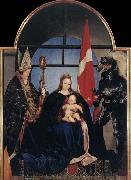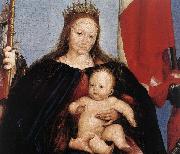
|
HOLBEIN, Hans the Younger
|
|||
|
|
|||
| German painter (b. 1497, Augsburg, d. 1543, London). Hans Holbein the Younger, born in Augsburg, was the son of a painter, Hans Holbein the Elder, and received his first artistic training from his father. Hans the Younger may have had early contacts with the Augsburg painter Hans Burgkmair the Elder. In 1515 Hans the Younger and his older brother, Ambrosius, went to Basel, where they were apprenticed to the Swiss painter Hans Herbster. Hans the Younger worked in Lucerne in 1517 and visited northern Italy in 1518-1519. On Sept. 25, 1519, Holbein was enrolled in the painters' guild of Basel, and the following year he set up his own workshop, became a citizen of Basel, and married the widow Elsbeth Schmid, who bore him four children. He painted altarpieces, portraits, and murals and made designs for woodcuts, stained glass, and jewelry. Among his patrons was Erasmus of Rotterdam, who had settled in Basel in 1521. In 1524 Holbein visited France. Holbein gave up his workshop in Basel in 1526 and went to England, armed with a letter of introduction from Erasmus to Sir Thomas More, who received him warmly. Holbein quickly achieved fame and financial success. In 1528 he returned to Basel, where he bought property and received commissions from the city council, Basel publishers, Erasmus, and others. However, with iconoclastic riots instigated by fanatic Protestants, Basel hardly offered the professional security that Holbein desired. In 1532 Holbein returned to England and settled permanently in London, although he left his family in Basel, retained his Basel citizenship, and visited Basel in 1538. He was patronized especially by country gentlemen from Norfolk, German merchants from the Steel Yard in London, and King Henry VIII and his court. Holbein died in London between Oct. 7 and Nov. 29, 1543. With few exceptions, Holbein's work falls naturally into the four periods corresponding to his alternate residences in Basel and London. His earliest extant work is a tabletop with trompe l'oeil motifs (1515) painted for the Swiss standard-bearer Hans Baer. Other notable works of the first Basel period are a diptych of Burgomaster Jakob Meyer zum Hasen and his wife, Dorothea Kannengiesser (1516); a portrait of Bonifacius Amerbach (1519); an unsparingly realistic Dead Christ (1521); a Madonna and Child Enthroned with Two Saints (1522); several portraits of Erasmus, of which the one in Paris (1523 or shortly after), with its accurate observation of the scholar's concentrated attitude and frail person and its beautifully balanced composition, is particularly outstanding; and woodcuts, among which the series of the Dance of Death (ca. 1521-1525, though not published until 1538) represents one of the high points of the artist's graphic oeuvre. Probably about 1520 Holbein painted an altarpiece, the Last Supper, now somewhat cut down, which is based on Leonardo da Vinci's famous painting, and four panels with eight scenes of the Passion of Christ (possibly the shutters of the Last Supper altarpiece), which contain further reminiscences of Italian painting, particularly Andrea Mantegna, the Lombard school, and Raphael, but with lighting effects that are characteristically northern. His two portraits of Magdalena Offenburg, as Laïs of Corinth and Venus with Cupid (1526), | |||
|
|
|||
|
The Solothurn Madonna new19/HOLBEIN, Hans the Younger-852328.jpg Painting ID:: 52189 |
1522 Limewood, 140,5 x 102 cm | ||
|
|
|||
|
HOLBEIN, Hans the Younger
|
|||
|
|
|||
| German painter (b. 1497, Augsburg, d. 1543, London). Hans Holbein the Younger, born in Augsburg, was the son of a painter, Hans Holbein the Elder, and received his first artistic training from his father. Hans the Younger may have had early contacts with the Augsburg painter Hans Burgkmair the Elder. In 1515 Hans the Younger and his older brother, Ambrosius, went to Basel, where they were apprenticed to the Swiss painter Hans Herbster. Hans the Younger worked in Lucerne in 1517 and visited northern Italy in 1518-1519. On Sept. 25, 1519, Holbein was enrolled in the painters' guild of Basel, and the following year he set up his own workshop, became a citizen of Basel, and married the widow Elsbeth Schmid, who bore him four children. He painted altarpieces, portraits, and murals and made designs for woodcuts, stained glass, and jewelry. Among his patrons was Erasmus of Rotterdam, who had settled in Basel in 1521. In 1524 Holbein visited France. Holbein gave up his workshop in Basel in 1526 and went to England, armed with a letter of introduction from Erasmus to Sir Thomas More, who received him warmly. Holbein quickly achieved fame and financial success. In 1528 he returned to Basel, where he bought property and received commissions from the city council, Basel publishers, Erasmus, and others. However, with iconoclastic riots instigated by fanatic Protestants, Basel hardly offered the professional security that Holbein desired. In 1532 Holbein returned to England and settled permanently in London, although he left his family in Basel, retained his Basel citizenship, and visited Basel in 1538. He was patronized especially by country gentlemen from Norfolk, German merchants from the Steel Yard in London, and King Henry VIII and his court. Holbein died in London between Oct. 7 and Nov. 29, 1543. With few exceptions, Holbein's work falls naturally into the four periods corresponding to his alternate residences in Basel and London. His earliest extant work is a tabletop with trompe l'oeil motifs (1515) painted for the Swiss standard-bearer Hans Baer. Other notable works of the first Basel period are a diptych of Burgomaster Jakob Meyer zum Hasen and his wife, Dorothea Kannengiesser (1516); a portrait of Bonifacius Amerbach (1519); an unsparingly realistic Dead Christ (1521); a Madonna and Child Enthroned with Two Saints (1522); several portraits of Erasmus, of which the one in Paris (1523 or shortly after), with its accurate observation of the scholar's concentrated attitude and frail person and its beautifully balanced composition, is particularly outstanding; and woodcuts, among which the series of the Dance of Death (ca. 1521-1525, though not published until 1538) represents one of the high points of the artist's graphic oeuvre. Probably about 1520 Holbein painted an altarpiece, the Last Supper, now somewhat cut down, which is based on Leonardo da Vinci's famous painting, and four panels with eight scenes of the Passion of Christ (possibly the shutters of the Last Supper altarpiece), which contain further reminiscences of Italian painting, particularly Andrea Mantegna, the Lombard school, and Raphael, but with lighting effects that are characteristically northern. His two portraits of Magdalena Offenburg, as Laïs of Corinth and Venus with Cupid (1526), | |||
|
|
|||
|
The Solothurn Madonna new21/HOLBEIN, Hans the Younger-968442.jpg Painting ID:: 63710 |
1522 Limewood Museum der Stadt Solothurn, Solothurn The original painting by Holbein was revealed only after restoration by Thomas Brachert in 1971; it had been completely overpainted in the Pre-Raphaelite style by the 19th century restorer Andreas Eigner. Eigner's aim was twofold: not only to "beautify" the picture, but also to cover up the many wormholes that had appeared. Restoration showed up the extensive craquelure that had been covered over and which regrettably spoils the fine modeling of the flesh tones in particular.Artist:HOLBEIN, Hans the Younger Title: The Solothurn Madonna (detail) Painted in 1501-1550 , German - - painting : religious | ||
|
|
|||
|
Also Buy::. For Following Paintings / Artists / Products, Please Use Our Search Online: |









